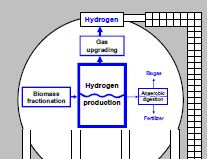
Bacteria can produce hydrogen from biomass but they take their time. In a new European project (HyTIME), nine partners including universities, knowledge centres and industry will examine ways to increase the hydrogen production rate during the next three years.
The core output of the project is the operation of a continuous fermentation process for the production of 1-10 kg hydrogen/day.
In this project, the residual biomass from the production of hydrogen by fermentation will be utilised to produce biogas via anaerobic digestion. The bio-methane can also be used as biofuel e.g. in cogeneration plants for thermal and electric energy production and/or in transport.
The aim of HyTIME is to show the possibility of full-scale application of this technology through the optimization of all the process parameters and the choice of the most efficient technologies currently available.
Hydrogen is regarded as the future fuel as its conversion to power is highly efficient. Bacteria can produce hydrogen from organic materials (such as grass, straw, and also fruit and vegetables no longer suitable for sale) when growing in the absence of oxygen. The so-called thermophilic bacteria fermenting biomass at a temperature of 70 degrees Celsius are the most productive.
This has been proven in previous hydrogen projects: Biohydrogen, EET-BioH2 and HYVOLUTION. Pieternel Claassen, researcher at Food & Biobased Research who led these previous hydrogen projects, is coordinating HyTIME.
The project is being headed by Wageningen UR Food & Biobased Research. Project partners are Heijmans Techniek & Mobiliteit B.V. and HyGear B.V. (The Netherlands), Awite Bioenergie GmbH and RWTH Aachen University (Germany), Environment Park SPA (Italy), Vienna University of Technology (Austria), Wiedemann-Polska Projekt (Poland) and Veolia Environment Recherche & Innovation (France).



